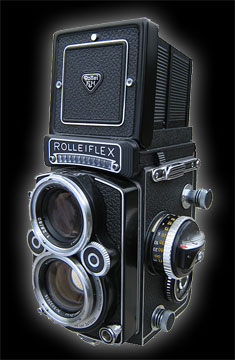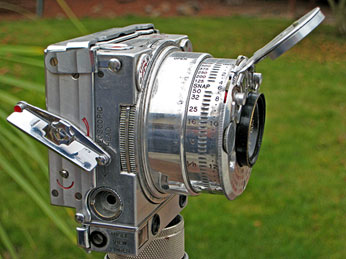Classic Camera Corner
Introduction to "Classic Camera Corner"
by Graham Law, President, Seawood
Photo
November 2007
In this
first installment of the Classic Camera Corner, I
thought it fitting to discuss why we love old cameras,
why they are still viable tools despite technological
advances in digital photography, and what to expect from
this blog in the future.
|

Rolleiflex 2.8F |
I don’t know when I
first became interested in classic cameras; I’m not
nostalgic about photography in my youth, and most of the
cameras I will discuss here were manufactured well
before I was born.
In my work I use the
latest high-end digital cameras and strobe equipment,
then edit my images in Photoshop just like 98% of the
other pro photographers nowadays. I really do love
the new stuff, but when I pick up a Rolleiflex 2.8F, or
a Leica M3, I know I have a real camera in my hands!
Anyone who appreciates fine machinery and workmanship
inevitably likes old cameras. It’s a fascinating
to see how they progressed from simple bellows cameras
with basic shutters at the turn of the (last) century to
the engineering marvels produced in the 1960’s.
With a few exceptions,
cameras built after the 1970’s hold little appeal to me.
Although new electronics allowed shutters and light
meters to be more accurate, and added features like
exposure modes, TTL flash, etc, made for faster, easier
shooting, the cameras just weren’t in the same league.
Mass production, cheap
plastic parts and a more disposable attitude created
changes in the industry. Smaller, independent camera
companies with a long history of quality such as Zeiss,
Voightlander, etc. could no longer compete with cheap
labor costs in Japan. The heyday of the classic,
hand-built camera was over.
On a more positive
note, there are millions of great Classic Cameras out
there in closets and attics just waiting for you to put
them to use! There are many great reasons to use
them, including:
- They are fun!
Some are so simple to use… you just aim and shoot!
Others, like my LeCoultre Compass, are so
complicated to operate that I have to re-learn the
controls every time I pick it up. Figuring them out
is half the fun.
- Results may
vary. Older, non-coated lenses give images a
very different look than modern optics. Soft focus,
lower contrast images can give you a look that is
difficult to imitate with your EOS 5D. On the other
hand, some older lenses are on par with today’s
best. Sometimes newer isn’t always better!
- They are
inexpensive. Except for rare collectible
cameras, you don’t have to spend much to buy a
precision made classic. Most of the hundreds of
cameras in the Seawood Museum I purchased for under
$20.00 at yard sales and flea markets. $200 will buy
you a old camera that would have cost your
grandfather four months salary when new. With so
many people dumping their film cameras for digital,
there have never been so many available, and that
has resulted in record-low prices.
- They interface
with modern technology. Why not scan your film
and digitally manipulate images shot with classics?
Just because the camera was made in 1938 doesn’t
mean you have to have to set up your own darkroom.
Unless you want to!
- Cameras are
like a box of chocolates. You never know what
you are going to get. It’s also fun to see how bad
some of them were! I have a simple Agfa Billy Record
6x9 camera that takes incredible images. Probably
cost $20 when new. By comparison, I also have a
high-end Voightlander Bessa II that has a great
reputation but produces mediocre results.

LeCoultre
Compass |
In future articles I
intend to write about how to use certain classic
cameras. I will be showing by example, with photos of
them and taken with them. I am not going to use a
collimator or resolution charts; if you like tech specs
and lens graphs there are lots of other sites dedicated
to such. This will be a simple hands-on approach
with a description of my experiences with the cameras
and the resulting images. I will also be ranting about
interesting camera histories and techniques.
I would love to have
your input on future subjects! E-mail me at
staff@seawood.com!
Keep ‘em shooting!
BACK TO CLASSIC CAMERA CORNER
INDEX > |



